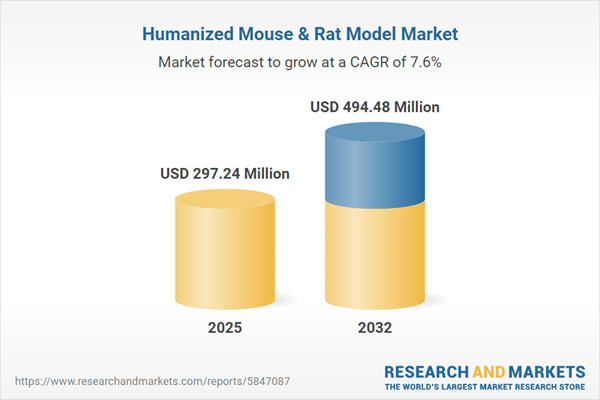Speak directly to the analyst to clarify any post sales queries you may have.
The humanized mouse and rat model market supports essential advancement in preclinical and translational research, enabling organizations to maintain scientific and regulatory rigor while building more reliable R&D programs.
Market Snapshot: Humanized Mouse and Rat Model Market Growth
In 2024, the global humanized mouse and rat model market is valued at USD 275.91 million, with anticipated growth to USD 297.24 million by 2025 at a CAGR of 7.56%. Ongoing priorities include investment in genetically engineered rodent models and enhanced predictive accuracy, driving adoption in pharmaceutical, biotechnology, contract research, and academic sectors. Region-specific factors such as research infrastructure, regulatory requirements, and local investment priorities shape both adoption and innovation. Companies are implementing tailored technologies and compliance strategies to sustain progress and manage operational complexity.
Scope & Segmentation
- Model Types: Humanized rat and mouse models, including gene-expressing lines such as hACE2 and hCD4, immunodeficient backgrounds, patient-derived xenografts (PDX), and knock-in or knock-out systems, support diverse study requirements across drug discovery and disease modeling.
- Applications: Models are used within research on cardiovascular disease, immunology, infectious disease, neuroscience—including pain and neurodegeneration—and oncology. Preclinical studies address both solid and hematologic cancers, providing organizations with a spectrum of disease-relevant insights.
- End Users: Academic institutions, CROs, pharmaceutical organizations, and biotech companies apply humanized rodent models to expand investigational pipelines, reduce preclinical variability, and streamline the translation of findings into clinical development.
- Product Types: Markets offer standardized rodents, custom strain creation, high-throughput screening, validation services, and integrated project management, each supporting greater research reproducibility and workflow efficiency.
- Regional Coverage: Activities and investment span the Americas, EMEA (with subdivisions in Western and Eastern Europe, the Middle East, and Africa), and Asia-Pacific. Technology deployment strategies and regulatory adaptation reflect specific local and regional market dynamics.
- Companies Profiled: Sector leaders include Charles River Laboratories International, The Jackson Laboratory, Taconic Biosciences, Inotiv, PerkinElmer, Crown Bioscience International, Biocytogen Pharmaceuticals, BioIVT, Cyagen Biosciences, and GemPharmatech, combining broad geographic reach with specialized regional operations.
Key Takeaways for Senior Decision-Makers
- Advanced humanized rodent models yield more dependable data, allowing preclinical programs to achieve enhanced translational alignment for therapies targeting complex conditions such as immuno-oncology and rare diseases.
- Patient-derived xenografts and state-of-the-art genetic engineering increase the depth and precision of disease modeling, supporting more accurate selection of candidate therapeutics and reducing late-stage attrition in development pipelines.
- Integrating CRISPR/Cas9 editing, in vivo imaging technologies, and computational analyses enables organizations to maintain both scientific excellence and regulatory congruence in animal model systems.
- Collaborative frameworks among academia, CROs, and industry partners promote robust knowledge sharing and more efficient validation, accelerating movement from research to clinical application.
- Adopting flexible service and pharmacokinetic models allows organizations to quickly adapt to changing research directives and evolving compliance landscapes.
- Ongoing compliance monitoring and strategic investment reviews strengthen resilience to operational and market shifts, maintaining access to critical research resources.
Tariff Impact and Supply Chain Adaptation
Recent changes in tariff regulation have prompted organizations to review sourcing, balancing domestic and international animal model supply. Adjustments include localizing production, supplier diversification, and increasing supply chain robustness. These initiatives coincide with efforts to optimize expenditures and sustain quality research collaboration, ensuring stable access to humanized rodent models despite evolving trade scenarios.
Methodology & Data Sources
This analysis reflects a combination of interviews with R&D leaders, regulatory documentation, industry publications, clinical evidence, and patent filings. The approach provides a complete view of competitive positioning, scientific trends, and innovation within the humanized mouse and rat model market.
Humanized Mouse and Rat Model Market: Why This Report Matters
- Provides detailed market intelligence and technology guidance, facilitating informed investment, procurement, and segmentation strategies for executives.
- Delivers essential context for adapting to scientific innovation, changing regulations, and optimizing research partnerships for greater impact in animal model research.
- Supports benchmarking and resource deployment, empowering organizations to prioritize efficient and high-impact initiatives in translational research.
Conclusion
Adopting humanized rodent models supports sustained scientific advancement, greater readiness for regulatory change, and long-term operational strength through ongoing market shifts.
Additional Product Information:
- Purchase of this report includes 1 year online access with quarterly updates.
- This report can be updated on request. Please contact our Customer Experience team using the Ask a Question widget on our website.
Table of Contents
3. Executive Summary
4. Market Overview
7. Cumulative Impact of Artificial Intelligence 2025
Companies Mentioned
The companies profiled in this Humanized Mouse & Rat Model market report include:- Charles River Laboratories International, Inc.
- The Jackson Laboratory, Inc.
- Taconic Biosciences, Inc.
- Inotiv, Inc.
- PerkinElmer, Inc.
- Crown Bioscience International, Inc.
- Biocytogen Pharmaceuticals Ltd.
- BioIVT, Inc.
- Cyagen Biosciences Inc.
- GemPharmatech Co., Ltd.
Table Information
| Report Attribute | Details |
|---|---|
| No. of Pages | 185 |
| Published | November 2025 |
| Forecast Period | 2025 - 2032 |
| Estimated Market Value ( USD | $ 297.24 Million |
| Forecasted Market Value ( USD | $ 494.48 Million |
| Compound Annual Growth Rate | 7.5% |
| Regions Covered | Global |
| No. of Companies Mentioned | 11 |









